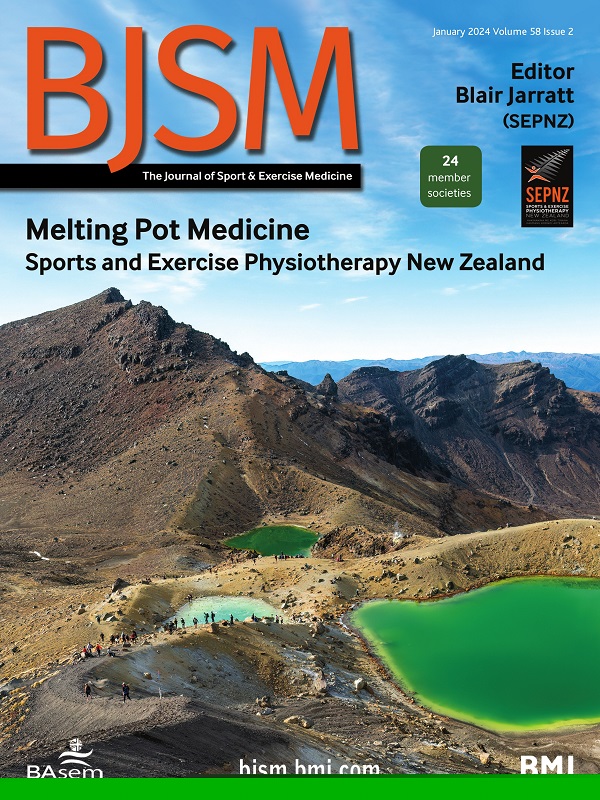如何在健康、受伤和临床人群中研究非限制性肌肉的血流限制阻力训练:范围回顾和证据缺口图
IF 16.2
1区 医学
Q1 SPORT SCIENCES
引用次数: 0
摘要
目的血流量限制(BFR)阻力训练可促进受限肢体的肌肉生长,但其对非受限肌肉的影响尚不清楚。本综述附有证据缺口图,旨在系统地绘制当前关于BFR对非限制性肌肉影响的文献,总结关键结果并确定方法趋势,以指导未来的研究。方法在PubMed、Scopus和Web of Science中进行检索。研究包括成年人-健康或患有肌肉骨骼疾病-接受BFR阻力训练,双臂或多臂设计的被动或主动比较组。数据集中于慢性生理(如肌肉特性)和身体健康(如力量、力量)适应。随机研究使用RoB 2 (Cochrane Risk of bias 2工具)评估偏倚风险,非随机研究使用ROBINS-I (Risk of bias in Non-Randomised Studies - of Interventions)评估偏倚风险。结果在1740份记录中,有19项研究(540名参与者,6名女性)符合标准。干预持续时间为2至12周,训练频率为每周2 - 6次,袖带压力为50-270毫米汞柱。报道最多的结果是1次重复的最大强度、肌肉横截面积和厚度。胸大肌和肩旋转肌是最常被研究的肌肉。大多数研究每周进行两到三次BFR训练,平均持续8周。有证据表明,BFR训练可能有益于非限制性肌肉,但研究方案的可变性、小样本量和有限的标准化阻碍了广泛的结论。未来的研究应采用一致的方法,更大的队列和更广泛的干预措施,以提高可比性和普遍性。OSF标识符:OSF -registrations-q8wcz-v1根据合理要求提供数据。所有的数据都可以通过请求提供给相应的作者。本文章由计算机程序翻译,如有差异,请以英文原文为准。
How blood flow restriction resistance training has been studied on non-restricted muscles in healthy, injured and clinical populations: a scoping review and evidence gap map
Objectives Blood flow restriction (BFR) resistance training enhances muscle growth in restricted limbs, but its effects on non-restricted muscles remain unclear. This scoping review, accompanied by an evidence gap map, aims to systematically chart current literature on BFR’s impact on non-restricted muscles, summarise key outcomes and identify methodological trends to guide future research. Methods Searches were conducted in PubMed, Scopus and Web of Science. Studies included adults—healthy or with musculoskeletal conditions—undergoing BFR resistance training, with passive or active comparator groups in two-arm or multi-arm designs. Data focused on chronic physiological (eg, muscle properties) and physical fitness (eg, strength, power) adaptations. Risk of bias was assessed using RoB 2 (Cochrane Risk of Bias 2 tool) for randomised and ROBINS-I (Risk of Bias in Non-Randomised Studies - of Interventions) for non-randomised studies. Results From 1740 records, 19 studies (540 participants; 6 women) met the criteria. Intervention durations ranged from 2 to 12 weeks, with training frequencies of 2–6 sessions per week and cuff pressures of 50–270 mm Hg. The most reported outcomes were 1-repetition maximum strength, muscle cross-sectional area and thickness. The pectoralis major and shoulder rotators were the most frequently studied muscles. Most studies implemented BFR training two to three times weekly for an average of 8 weeks. Conclusions Evidence suggests BFR training may benefit non-restricted muscles, but variability in study protocols, small sample sizes and limited standardisation hinder broad conclusions. Future research should employ consistent methodologies, larger cohorts and extended interventions to enhance comparability and generalisability. Trial registration details OSF identifier: osf-registrations-q8wcz-v1 Data are available upon reasonable request. All data is available by per request to the corresponding author.
求助全文
通过发布文献求助,成功后即可免费获取论文全文。
去求助
来源期刊
CiteScore
27.10
自引率
4.90%
发文量
217
审稿时长
3-8 weeks
期刊介绍:
The British Journal of Sports Medicine (BJSM) is a dynamic platform that presents groundbreaking research, thought-provoking reviews, and meaningful discussions on sport and exercise medicine. Our focus encompasses various clinically-relevant aspects such as physiotherapy, physical therapy, and rehabilitation. With an aim to foster innovation, education, and knowledge translation, we strive to bridge the gap between research and practical implementation in the field. Our multi-media approach, including web, print, video, and audio resources, along with our active presence on social media, connects a global community of healthcare professionals dedicated to treating active individuals.

 求助内容:
求助内容: 应助结果提醒方式:
应助结果提醒方式:


